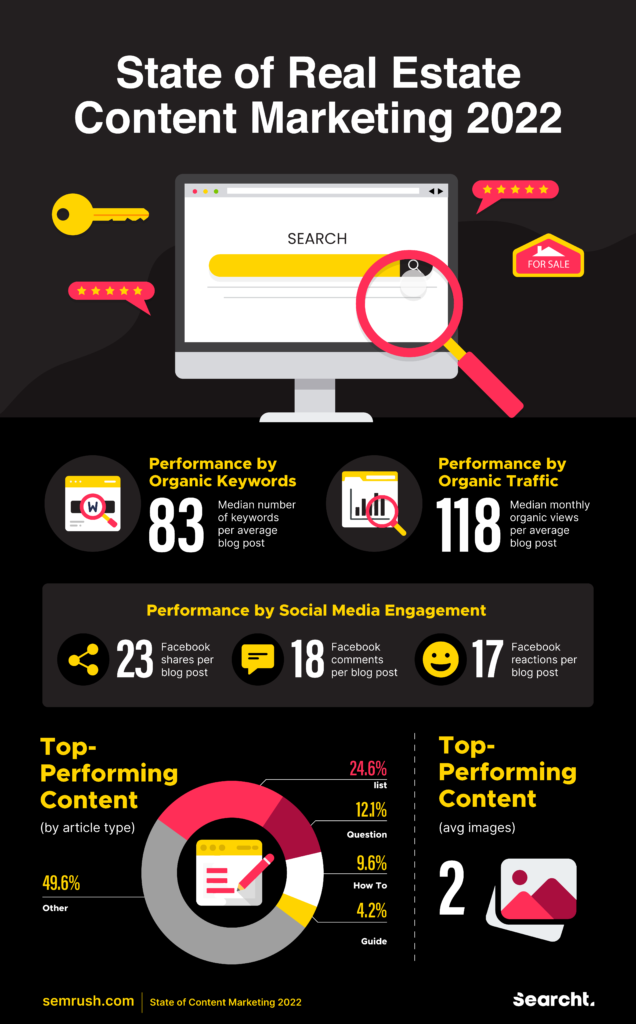Most agent websites will now have a blog. Many will even have hundreds of blog posts published.
But what are they achieving?
Do you have a strategy for your content marketing? What are the objectives for your content? What are you trying to achieve? Is it performing?
Of course, you can continue producing and publishing content with little to no intention and choose to ignore its performance. But at what cost?
You’re likely paying for a writer, so there’s that cost. But what about the ‘opportunity cost’? The cost of what you’ve missed out on because there is a lack of strategy behind your content marketing.
What is Content Marketing?
Let me start with what it is not and that’s new. John Deere is often the example referred to when we talk about the genesis of content marketing. The company launched an agricultural magazine, The Furrow, way back in 1895. It was a pure content marketing play in the true sense. Farmers read the magazine and bought John Deere machines.
“Content marketing is a strategic marketing approach focused on creating and distributing valuable, relevant, and consistent content to attract and retain a clearly-defined audience — and, ultimately, to drive profitable customer action.”
Content Marketing Institute
Content marketing must be more than just writing a blog post. To be successful in it achieving your objectives, significant time must be invested and it’s the sort of time that requires a content marketing strategy. More on that later.
Why is Content Marketing Important for Real Estate Agents?
In years past, if you wanted to sell your house you would invite a few local agents around and listen to their pitch. Then the decision was made. The process now involves a lot of online research that is done well before contacting an agent. And they won’t invite three or four, they’ll likely invite just one.
So this presents a challenge and an opportunity for real estate agents. To identify the online journey and the opportunities that exist to ‘be there’ and ‘be helpful’.
And it’s not just to attract ‘sellers’. Online research is being done by buyers, renters, and rental providers.
For buyers, the user journey is now reported to be around 20 months. So there is a great deal of consideration being undertaken and a thirst for valuable information.
Research from Google found that:
“People searching about real estate listings are 5x more likely to search about planning for retirement and 4x more likely to search about finding child care.”
There are other benefits to producing content:
– Brand Awareness
Real estate branding is everywhere and you likely already understand its importance. From property signage to bus stops to local sponsorships, it’s important for the community to keep your agency front of mind. This should be no different online. But it’s even more powerful when buyers, sellers, or landlords are introduced to your agency at the moment they are researching to buy, sell or rent out a property.
– Build Trust (rep bad & do business)
We know that people like doing business with those they trust. The problem with real estate, there’s not a lot of trust in the space. But with every problem, there is an opportunity for you to be the standout and establish trust with those who are yet to even call your office or meet you in person.
– Nurture & Convert
It’s not hard to understand that you have an opportunity to be visible with your audiences during the moment they are doing online research. But for those a little more cynical, it can be hard to tie that to your business objectives. That’s where your strategy needs to be clear about how you will nurture and convert these visitors and how you’re going to measure it. For example, a buyer might be looking for a suburb profile as they look to make a decision on where to buy. They could get that from you and never come back or you could get them subscribed by email and drip-feed valuable information along their journey until they are ready to contact an agency. And at that moment, it is likely to be you.
– Social Ammunition
No matter your appetite for Facebook and Instagram, there is an opportunity to reach your audiences via social media. But what do you post? What drives engagement? Your blog posts will be a great source of content for your social media manager to post to social and it is valuable.

Examples of Real Estate Content Marketing
So far, we’ve established the importance of content marketing and how it can be a game-changer in attracting sellers, buyers, renters, and rental providers. We’ve looked at its role in creating brand awareness, building trust, nurturing and converting clients, and how it serves as social ammunition. Now let’s take a look at examples of content to get you started.
Great Examples
RealEstate.com.au
‘How much does it cost to sell a house in 2022?’
https://www.realestate.com.au/advice/how-much-does-it-cost-to-sell-a-house/
Targeting the audience looking to sell a house we can clearly understand the business objective. This post, which looks like was first published in November 2016 and most recently updated in January 2022 generates an estimated 8.3k Australian users from organic search every month. It ranks among 173 search terms in Google’s Top 3 results including high-volume terms such as – real estate commission fees, and real estate agent fees. What’s even more incredible is that the estimated value of the organic performance of this post is $28.6k per month. That is, if a competitor wanted to achieve the same visibility with Google Ads, then they would need to spend this figure each and every month. This one post has a higher estimated traffic cost than the 948 posts at https://www.domain.com.au/advice/.
LJ Hooker
‘The Difference between Wear and Tear vs Accidental Damage’
https://www.ljhooker.com.au/blog/latest-blog/july-2019/wear-and-tear-vs-accidental-damage-explained
The most visible post of the 381 on the LJ Hooker website generated approx 16% of the organic traffic to the blog. The intention is clear – LJ Hooker is providing a valuable resource to landlords or tenants when they are searching for information around ‘fair wear and tear’ as to the state of the rental property at the end of the lease.
Love & Co
‘Suburb Profile: The Ultimate Guide to Mill Park’
https://www.lovere.com.au/mill-park-suburb-profile/
The only blog post that Love & Co has in its top 10 pages generating organic traffic. The post is targeting potential buyers or tenants looking to move to Mill Park. The post ranks prominently for search terms such as – is Mill Park a good suburb? Mill Park suburb profile, and Mill Park property prices. But beyond the search results, this content provides a great deal of value to this target audience and will generate a positive brand experience.
It should be said that such examples of ‘localised’ content is really where the agent has a strong opportunity against the big marketplaces and their content budgets.
Not so Great Examples
Ray White
‘Have we all rushed to the cloud too soon?’
https://www.raywhite.com/blog/our-family/have-we-all-rushed-to-the-cloud-too-soon/
This post is the most successful of the 403 posts on the Ray White blog generating an estimated 10% of organic traffic to the blog. A whopping 88% of the organic traffic to this post comes from 110 people searching ‘value ray white’. It’s clearly targeted at franchisees and employees of Ray White, which is an interesting strategy. There is no value to the traditional buyers, sellers, rental providers, or tenants, so why not distribute this content via internal channels? The performance of this post also highlights the lack of strong content for traditional audiences.
First National
’10 Best Dog Breeds for Apartments and Small Yards’
https://content.firstnational.com.au/blog/10-best-dog-breeds-for-apartments-and-small-yards/
Of the 146 posts on the First National blog, this post is the most successful generating 37% of the organic blog traffic. But what is the objective behind this post? It ranks #1 for ‘best dogs for small yards’ and it has 110 Aussies searching just that one term every month. If search traffic alone is their objective, then I would suggest they look to better optimise for ‘best apartment dogs’ which has a whopping 1,300 Aussies searching each month but it ranks #86. Perhaps they identify their target audience as having small yards more so than apartments? It does seem like the type of content that would be great for social but after two years it’s yet to generate a Facebook or Twitter share.
How To Develop Your Content Marketing Strategy
If you’re looking to develop your content strategy in-house without external support, then hopefully you’ll find the following basic step-by-step guide valuable.
1. Establishing Your Goals/Objectives
The first task you want to undertake is identifying why you are investing in content marketing. This can be varied depending on the nature of your agency.
– Some agencies may simply want to create posts that are published to distribute to their social accounts in order to keep their community engaged.
– Others may wish to publish the latest property data as more of a thought leadership play.
– You may have an email newsletter in which you want blog posts to help attract new subscribers as well as add more value to the emails.
– And many will want to use their content as a strategy to attract, nurture, and convert readers into clients.
But you must be clear on why.
2. Identifying How You Will Measure Success
If you don’t know how you will measure your success, how do you know if it’s worth continuing to invest?
How you choose to measure your success, will of course be dependent on your objectives.
Let’s look at the hypothetical objectives above.
– If you’re using your blog posts as social ammunition, then you will want to monitor and assess your content’s performance based on social reach and engagement numbers.
– If you’re wanting to publish thought leadership pieces, then it will be trickier to measure. You may look at consumer surveys to measure how your audience views your agency in terms of a thought leader. Other options may be online citations and even inbound links.
– If your content is a lead-gen for your email database, then of course email subscriptions generated from blog posts will be your key metric. Clicks on your blog posts within email newsletters will also help you to measure the value they provide to your newsletters.
– If you’re wanting to attract, nurture, and convert people to clients, then you have a range of measurement options, all of which should influence your evaluation. Traffic from search is one. Repeat visits another. Email subscriptions too. And of course enquiries, no matter the nature of them.
You should consider that the user journey can be long, so in many cases, a visit to a blog post will not lead directly to an enquiry in one session. You need to be able to have the tracking in place to identify if an enquiry tomorrow came from a blog post today, last week, or even 19 months earlier.
3. Identifying and Understanding Your Cohorts
If you haven’t defined who your audience is, how could you expect to deliver maximum value in order to leverage optimal returns?
Your objectives will provide clarity on who you are targeting. If you’re targeting buyers for instance, then clearly define who they are, and what their journey looks like with what information they’re looking for. Understand their language and their pain points. This process should also identify if they want short-form or long-form written content, video, or emails.
4. Topic Research
Your team possesses an intimate knowledge of each cohort, so brainstorming is a great way to start identifying topics to cover. Try to map out each cohort’s journey with the information they’re seeking with the aim of having a content asset for each step.
But from there you want to conduct some keyword research no matter your objectives because understanding how many people are searching for particular phrases is not only good for SEO but hey, it is an insight into the language your audiences are using.
This process may enlighten you as to what type of content you want to produce. For example, you could focus on – property data and insights, how-to guides and checklists, suburb profiles, relocation guides, or all of the above.
5. Create an Editorial Calendar
It’s always a great idea to establish an editorial calendar and ensure all the relevant people within your agency have access.
It not only holds everyone accountable for seeing the content gets published but it can also prevent ad-hoc, brain-fart content from being produced.
Note: If you do have a lot of ‘brain-fart content’ under-performing, consider a content audit – You may find you need to prune a lot of your content, while optimising others.
6. Content Writing
Of course, this is the proverbial nuts & bolts and often step one of the too many content strategies.
I strongly recommend that, if you’re asking your team to write that you turn to ‘the most qualified’ person on the given topic. Don’t worry that they are not confident in their writing abilities or that ‘grammar has never been a strong suit’. All posts should be proofed by an expert no matter the author. This will help to establish a level of trust between the reader and your content, ultimately helping to achieve your content objectives. For those interested in improving search performance, this can be a critical factor.
If you do seek external support, then you should expect to receive a content brief before starting to write. Such a brief, backed up by more in-depth keyword research and an analysis of the top-performing competitor content will help guide the structure of your content and give you a better chance of success.
7. Content Promotion
One of the biggest omissions from the content strategy is promotion. Too many businesses publish posts and then sit back and wait for people to come. For the time and effort invested up to this point, it’s crazy not to invest a little more to ensure more people see the content and your chance of success is greater.
I would recommend creating a promotional checklist so that everyone knows and understands, that once a post is published it needs to be promoted. The checklist should involve many or all of the following:
– Email newsletter
– Social accounts (schedule multiple posts over time)
– Agent email signatures
– Agent’s own social profiles
– Social advertising
– Internal linking from other posts & pages
– Answering relevant questions on Quora
– Google Posts
Optimising Your Blog Page Layout
There are a number of specific items that make up the optimal blog post page. Here are a few to consider.
Share Options – We want to amplify our content and it doesn’t get easier than providing a social share button. Don’t go crazy though. Facebook and Twitter are straightforward choices and depending on the nature of your agency you may choose to include LinkedIn.
Author Bio – This helps to establish trust with your audience. If they’re going to trust the advice you’re sharing, then they should know who is sharing it and be able to confirm your knowledge or expertise. A photo is important.
Related Posts – Blog posts will often be the first page a user lands on at your website and posts will typically have a high bounce rate (people leaving without browsing further). So you want to be able to encourage them to browse further. Adding related posts is one way of doing so.
Sticky CTA – Sharing your knowledge and experience in your content marketing is more than just a goodwill gesture. Ultimately it should be aligned with your business objectives. That’s why in many instances you want to display a Call To Action (CTA). Which CTA this should be is for another day but look at implementing a sticky CTA to maximise your chances of action. For example, a sticky CTA will continue down the screen, typically to the right of the content, as you read.
Optimised for Mobile (speed) – Blog posts generally lean more toward mobile devices. So make sure that you’re aware of the mobile experience and that the page speed is not an issue.
Images/Media – You definitely need a featured image. These will be seen when someone shares your post on social media. But you should have more media, whether it be images or video to help complement the content and add to the user experience.
Meta Titles & Descriptions – Make sure you complete your meta title and description. This is what we ask Google to use when they show the result in searches. Now they won’t always show what we’ve asked but again that’s for another day. Just make sure you explain accurately what the user can expect from reading and try to be compelling.
The Takeaway
The SEMRush State of Content Marketing Report 2022 identified that 97% of surveyed brands used content marketing but only 57% had a documented content marketing strategy.
So If you don’t have a content marketing strategy right now, don’t fret but it’s time to get started if you want the first-mover advantage. And that’s what is on the table.
Do REA and Domain have a documented content strategy – I’d be blown away if they didn’t. But again, where they are big, you are small and there are inherent advantages to that, particularly around your ability to localise your content marketing.
Does your local competition have a documented content strategy? Reach out to me if you’d like me to check them out and give my opinion but I doubt they do.
So stop wasting your existing content budgets and develop your content strategy.

